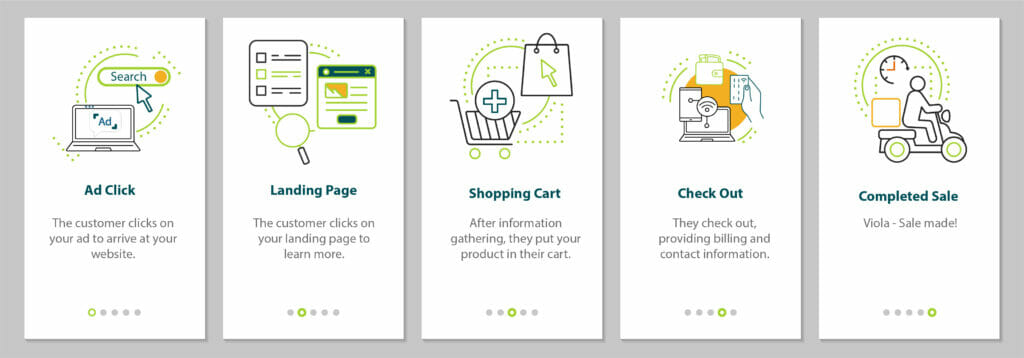using GA to understand your purchase path

If we’ve said it once, we’ve said it a million times: we love data! You can understand a lot about your customers’ buying behavior by looking at the data gathered by Google Analytics. For businesses using their websites as a point of sale, this tool can be especially helpful. In this post we talk about how Google Analytics can help you better understand your purchase path, and how to use that information to get smarter about the ways you run your campaigns or allocate your digital resources.
know your purchase path
On the surface it might seem simple, a customer goes to your website and buys your product. What we want to determine is what are the digital steps–or clicks–my prospective customer must take in order to make a sale? Do you have a three step sales path, or five step? Are people arriving at your site organically, or via an ad campaign? Here’s an example of what this could look like:

connect the path to Google Analytics
Once you have clarity surrounding the steps in your sales path, the next (and possibly the most important) step is to make sure everything is connected to Google Analytics so it can gather information.
For example, in the sales path above the first step is that the customer clicks on an ad to arrive at your website. Perhaps you have ads coming from multiple sources such as Facebook, Google Display Network, and a native ad placement. It’s crucial to make sure there are pixels placed on these ad sources and that they are feeding information into your Google Analytics account. The same goes for each of the other steps along this process. This will give us information like how many people are coming to the site, where they’re coming from, what they’re clicking on when they arrive, and if they’re moving from step 1 through step 5 in your purchase funnel.
explore customer behavior
Now it’s time to look at what action your prospects are taking along the way. By examining this, it can give you information about how your sales path is performing. For instance, if you aren’t receiving ad clicks to your site at the very beginning of your sales funnel, then you know you have some possible changes you could make upfront.
Here’s another possible scenario. Let’s say you’re seeing very high traffic consistently until they get midway through your process. They reach the point where you guide them to learn more and they begin to drop off. Put yourself in the shoes of your consumer and ask why this might be. Is the information necessary to get them to the next point in the process? It could be that the information is necessary and in the right place, but it needs to be adjusted for readability, shortened, or the tone could shift.
Sometimes we see a sales process where prospects are making it all the way to the end of the sales journey and dropping off at the shopping cart. Again, explore the options as to why this may be happening. Is this an issue with the functional mechanism of the shopping cart itself? Or perhaps there was no mention of price along the way and customers landed at the end to see a high price point that caused them to bounce.
test pathway tweaks
If you’ve determined some points along your sales journey aren’t performing the way you’d like, this is where you have the ability to make tweaks, test, and measure the outcome. Let’s look at the examples above in reverse order.
What changes can you make if customers are dropping off at the very end? In the case of a broken shopping cart, the answer is relatively simple. Fix the cart, make sure you’ve reconnected GA, and track to see what percentage of folks complete after the fix. If prospects are dropping off due to sticker shock at the end, are there any changes you could make to better qualify your leads? Maybe that means going back to the very beginning and targeting an audience in a higher income bracket, or there may be room to mention price earlier in the sales path. If none of these changes are a fit for your business model, this information may be telling you your consumers are behaving exactly the way you expect them to. From there, you can focus on optimizing your campaigns for frequency because GA is confirming that your purchase cycle involves some incubation time given the price point.
When prospects get midway through a process and drop off there may be a few different things to test. One possibility is to create two different landing pages, one with the same content as before and another with adjustments. Copy, imagery, call to action, layout or other factors could all be causing the issues and are worthy of testing. It’s important to test one element at a time so that you can easily identify what’s causing the change in results. AB test to see which landing page moves your prospect onto the next step. If you don’t see a significant difference in traffic, you can test removing the step altogether.
Examining the beginning of your sales path can provide some really meaningful information. If you find that the majority of your traffic is getting into your purchase path from a particular platform, then it might be a sound strategy to shift funds and attention in that direction. For instance, if you’re seeing most of your site visitors from organic traffic, you may decide it’s worthwhile to spend time and resources optimizing SEO for the long haul and adjusting your paid ad spend to a reach and awareness strategy rather than focusing on conversions. If you’re running a multi-platform campaign and one is the clear winner, you can then funnel the bulk of your digital dollars into that channel instead of the ones that aren’t working as well. Conversely, you may have opportunities to tweak and AB test creative to see if different messages reach your target audience better on different channels.
Connecting GA to your campaigns can help you understand the steps your customers are taking to streamline your purchase path, not waste money, and discover new avenues to expand into more effective means of converting customers. If you want to brainstorm about your unique sales goals or just want a listening ear as you figure out how to break down your customer’s purchase cycle – hit us up!
Go forth. Go digital.
-cohort.crew



